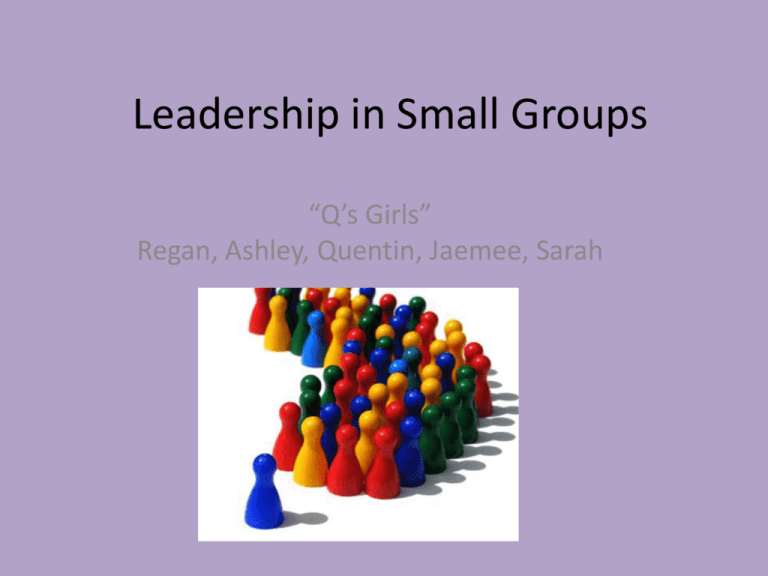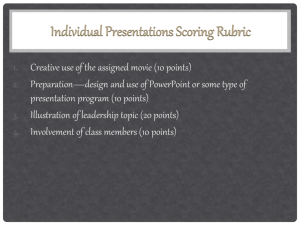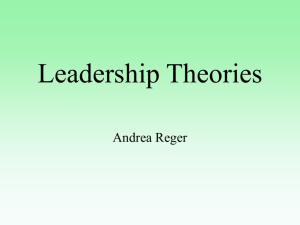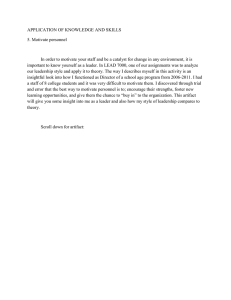Leadership in Small Groups
advertisement

Leadership in Small Groups “Q’s Girls” Regan, Ashley, Quentin, Jaemee, Sarah Leadership is…? • Leadership is defined as however we see it at “that point in time.” • There are almost as many ways to define leadership as there are people who have tried to define it. • Some define leadership as an act or behavior- the things leaders do to bring about group change Leadership: Components and Definition • Leadership is a process: - A transactional event that occurs between a leader & his or her followers • Leadership involves influence: - How the leader effects his or her followers - Without influence, leadership does not exist • Leadership occurs in groups: - This is the context where leadership takes place Leadership: Components and Definition Continued… • Leadership involves common goals: - Mutual purpose for the whole group *Stressing mutuality lessens the possibility leaders might act in unethical ways Leadership Definition (based off of components) Leadership: - Leadership is a process whereby an individual influences a group of individuals to achieve a common goal. (leadership is interactive, this definition makes it available to everyone) Conceptualizing Leadership • According to Fleishman et al. (1991) “In the past 60 years, as many as 65 different classification systems have been developed to define the dimensions of leadership” (as cited by Northouse, 2010, p. 2). Conceptualizing Leadership • Focus of group process - In this perspective the leader is at the center of the group • Transformational process -the leader moves followers to accomplish more than is usually expected of them • Personality perspective -states that leadership is a combination of special traits or characteristics and individual possesses Leadership is a power relationship Two Categories of Leadership • Trait v. Process Leadership (picture) – Trait: • Individuals have special qualities that they were born with • (physical features-height, personality-extravert, intelligence, fluency) • Restrictive on those who don’t possess these features – Process • Information processing, perspective or relational standpoint Assigned v. Emergent Leadership • Assigned: – Individual is occupying a position in an organization • plant managers, department heads, directors, administrators – Not always viewed as the leader • Emergent: - When an unassigned member becomes viewed as the leader of the group no matter what title emerges over a period of time through communication - Verbally involved, stay informed, seek other’s opinions, initiating new ideas, firm but not rigid -Dominant, intelligent, confident • From social theory: leadership emergence is how the person fits with the identity of the group as a whole, usually most like the group prototype The Four Factors of a Group: 1. 2. 3. 4. Establish overall intention and clarity of vision Building the team moral Monitor behavioral concerns between group members Keep focused on group goal Responsibilities of a Group Leader: • Be aware of tension within the group • Overcome obstacles • Establish goals for group • Keep group focus on tasks • Keep group motivated to reach goal Four Primary Tensions Within a Small Group: • Managing commitment to the group and life activities • Whether group activities were ordered and predictable and unplanned and spontaneous • Whether group boundaries included or excluded certain members from group activities • What were acceptable and unacceptable member behaviors and norms Dialectical Theory • Contradiction: “The essence of dialectic theory is contradiction, the ‘dynamic interplay between unified opposition’ that ‘mutually negate’ one another” (Baxter & Montgomery, 1996, p. 8) (as noted in Galanes, 2009, p. 411). • Change: “Assumes social relationships are always in the process of becoming, creating a dialectical interplay between stability and change” (Galanes, 2009, p. 411). •Praxis: “How participants in a relationship act communicatively within the relationship (Baxter & Montgomery, 1996, p. 8) (as noted in Galanes, 2009, p. 412). •Totality: “All communicative behavior is contextual, understood only relative to other phenomena” (Galanes, 2009, p. 412). History Past-Present • 1920s and 1930s – • 1940s: – • group dynamics and development of social scene 1950s: – • focusing on human relations movement on collaborative efforts at work v. individual efforts sensitivity training and T-groups 1960s and 1970s: – focused on organizational development developing team and leadership effectiveness through intervention 1980s: focus on quality teams, benchmarking, and continuous improvement 1990s: focus on organizational teams, still focusing on quality, shifted to global perspective focusing on organizational strategies maintaining competitive advantage, focus on problems confronting organizational teams, use of teams leads to greater productivity, services, innovation, creativity, and failures are greatly visible More recent: more complex focusing on team variables rather than outcome. Investigates role of affective, behavioral, and cognitive process in team success and viability. Found that effective team leadership is critical to team success and ineffective leadership leads to failure Classical/Scientific Management Theory • Henri Fayol (1841-1925) • Key Concepts of Classical management theory: • Planning, organizing, commanding, coordinating, ruthless efficiency, quantification, predictability, deskilled jobs and controlling • Style encourages mechanization of jobs • Bureaucracy is name of the game Behavioral Era • Focus on effect communication between leaders and followers • Leaders need to motivate followers • Humans are more complex • Highly influenced by Behavioral Psychology and B.F. Skinner Late 1940s • Academics moved focus of study away from leader to follower • Abraham Maslow (1908-1970) – Hierarchy of Needs • Group members productivity would only be possible if a member’s physiological, security, and social intrinsic needs were met • Herzberg’s Dual Factor Theory – Intrinsic/extrinsic needs can be met at the same time Leadership Scholar: James MacGregor Burns • 1978 – Transformational /Transactual Leadership – power is not to dominate or achieve one’s own ends, but is within the relationship to promote collective goals through mutual process – Individual holds power within a group • Potential to influence members • Collaboration – Ministers, doctors, coaches, and teachers Transformational Leadership • Leaders motivate followers to work together to change group to increase productivity • Focus on the future and goals • Leaders surface assets of group members • Transformation creates climate of trust – Idealized and charismatic influence – Inspiration motivation – Intellectual stimulation – Individual consideration • Downfalls – Based on the abilities of the leader – Quality is based on level of morality Leadership Roles & Power with: Bertram Raven and John R. P. French • 1959 • Bases of social power: – Referent power: based on followers’ attitudes toward the leader • teacher – Expert power: based on followers’ perception of leaders competence • tour guide – Legitimate Power: having status or formal job authority • judge – Reward Power: leader has capacity to provide rewards to members • supervisor – Coercive Power: capacity to penalize or punish others • coach • Designed these five bases of power to see how power works or fails in specific relationships. • Believed power to be relative and depends on specific understandings between the people in the given relationships. (If A could convince B or if A could motivate B) Future of Leadership: Servant Leadership Theory • Higher concern for people to be primary focus of the leader • Leadership based on teamwork, community, values services and caring behavior • Primary objective is the worker and their personal growth • Leaders gain influence through 7 Behaviors: – Agape love, humility, altruism, vision, trust, empowerment and service Leadership in Small Groups Now Go Be a Leader!!!! “Q’s Girls” Regan, Ashley, Quentin, Jaemee, Sarah References • • • • • Northouse, P. G. (2010). Leadership: Theory and Practice. CA: SAGE Publications Inc. Stone, A. & Patterson, K. (2005). The history of leadership focus. Retrieved from http://www.regent.edu/acad/global/publications/sl_proceedings/2005/stone_hist ory.pdf Jalanes- Jaemee Wheatley Mine (2)











